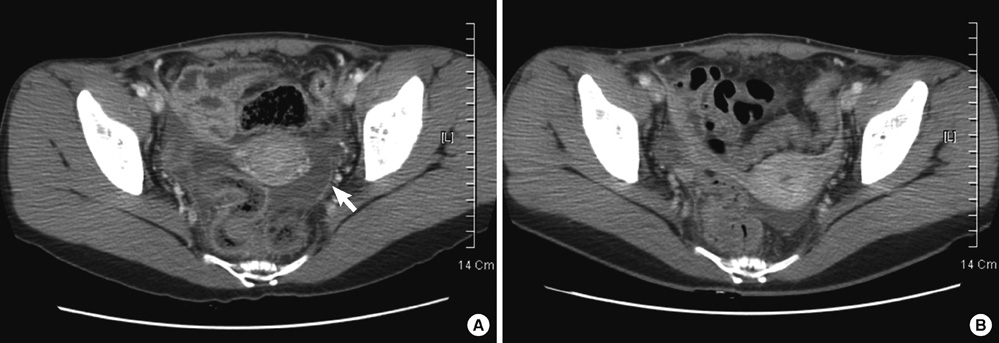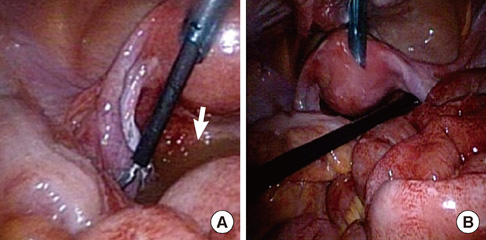J Korean Med Sci.
2012 May;27(5):553-555. 10.3346/jkms.2012.27.5.553.
Unusual Primary Peritonitis due to Streptococcus pyogenes in a Young Healthy Woman
- Affiliations
-
- 1Division of Infectious Diseases, Department of Internal Medicine, Kyung Hee University School of Medicine, Seoul, Korea. mslee@khmc.or.kr
- 2Department of Obstetrics and Gynecology, Kyung Hee University School of Medicine, Seoul, Korea.
- KMID: 1372800
- DOI: http://doi.org/10.3346/jkms.2012.27.5.553
Abstract
- We describe the first case of primary peritonitis in Korea of a healthy person due to Streptococcus pyogenes. In the absence of comorbid conditions, such as liver cirrhosis, immunosuppression, or nephrotic syndrome, primary peritonitis is uncommon in a young healthy woman. Abdomen computed tomography revealed ascites in the lower abdomen and peritoneal enhancement suggesting peritonitis. In diagnostic laparoscopy, purulent ascites was found in the pelvic cavity but both ovaries and fallopian tubes were intact. There were no intra-abdominal abnormalities such as bowel perforation, appendicitis, or necrosis. The reports of blood culture, ascites culture, and cervical swab culture confirmed S. pyogenes. After use of antibiotics, the patient was cured and discharged without sequelae.
MeSH Terms
Figure
Reference
-
1. Jung HS, Park SE, Lee HJ, Kim EC, Kim JH. Clinical features of infections caused by streptococcus pyogenes in children and their antimicrobial susceptibility. Korean J Infect Dis. 1998. 30:419–425.2. Capdevila O, Pallares R, Grau I, Tubau F, Liñares J, Ariza J, Gudiol F. Pneumococcal peritonitis in adult patients: report of 64 cases with special reference to emergence of antibiotic resistance. Arch Intern Med. 2001. 161:1742–1748.3. Moskovitz M, Ehrenberg E, Grieco R, Chamovitz B, Burke M, Snyder D, Book M. Primary peritonitis due to group A streptococcus. J Clin Gastroenterol. 2000. 30:332–335.4. Brivet FG, Smadja C, Hilbert U, Vons C, Jacobs F, Gordji-Therani H, Musset D. Usefulness of abdominal CT scan in severe peritoneal sepsis linked to primary peritonitis. Scand J Infect Dis. 2005. 37:76–78.5. Farooq A, Ammori BJ. Laparoscopic diagnosis and management of primary bacterial peritonitis. Surg Laparosc Endosc Percutan Tech. 2005. 15:36–37.6. Rivers E, Nguyen B, Havstad S, Ressler J, Muzzin A, Knoblich B, Peterson E, Tomlanovich M. Early Goal-Directed Therapy Collaboratie Group. Early goal-directed therapy in the treatment of severe sepsis and septic shock. N Engl J Med. 2001. 345:1368–1377.7. Vuilleumier H, Halkic N. Streptococcal toxic shock syndrome revealed by a peritonitis. Case report and review of the literature. Swiss Surg. 2001. 7:25–27.8. Gavala A, Klimopulos S, Exarchos D, Konstantinidis K, Daniil Z, Zakynthinos SG, Zakynthinos E. Persistent primary peritonitis due to group A Streptococcus and E. coli. Intensive Care Med. 2002. 28:1829–1831.9. Auskalnis S, Bogusevicius A, Maleckas A, Butrimavicius S, Toker I. Primary peritonitis caused by group A beta-hemolytic streptococcus. Medicina (Kaunas). 2004. 40:969–974.
- Full Text Links
- Actions
-
Cited
- CITED
-
- Close
- Share
- Similar articles
-
- Streptococcus pyogenes : Recent Research Provides New Insights into an Important Pathogen
- Necrotizing Pneumonia Complicated by Streptococcus Pyogenes Bacteremia in Patient with COPD
- Bacteriologic characteristics and serotypings of Streptococcus pyogenes isolated from throats of school children
- A case of streptococcus pyogenes endophthalmitis following cataract surgery
- Serotypes of Streptococcus pyogenes isolated from healthy school children in Kangwon-do



